Content and Conversion: How Your Company Blog Can Boost Sales Figures
Investing in Content Marketing to boost organic traffic to your website is always a great idea. See how Effective Content Can Boost Sales Figures

For most businesses, content marketing serves the purpose of driving organic, quality traffic to their websites. And it’s no surprise, considering that producing and distributing content makes for an excellent method for raising brand and product awareness and can be used as the initial hook that gets consumers interested in a particular solution.
But what if there was more to content marketing than just reaching your audience?
One of the most commonly overlooked benefits of investing in content is that it can significantly boost sales figures.
With just a little bit of planning and preparation, a content strategy can quickly transform from being a mere traffic generation tactic to an integral part of your sales funnel. Even more, employing a few tried and tested methods when planning your content can be a superb way to move your prospects through the funnel and achieve your goals more quickly, whether they consist of generating leads, making sales, or boosting your CLV.
So, if you’re ready to utilize your company blog for more than just visibility, the following six strategies are guaranteed to help you produce content that converts and helps you warm up your leads before cold calling.
Cater to Readers That Are in the Decision Stage of the Buyer’s Journey
If you want to effectively use your company blog to boost sales, you first have to understand one key thing: why people read blogs (or use the internet) in the first place.
According to The Digital 2022 October Globar Statshot Report, the most prominent reason people use the internet is to find information, with 58.4% of users going online for this purpose. Furthermore, the same resource discovered that 44% of consumers go online to research products and brands. With these two data points in mind, it becomes evident that one of the best ways to employ content is to use it to supply your target audience with the knowledge they seek throughout their buyer’s journey.
One way to do this would be to optimize your product pages to be user-friendly, informative, and conversion-oriented. However, remember that not all of your prospects will be in the action stage of the sales funnel. Moreover, understand that presenting leads with sales-oriented content too early is more than likely to alienate them and turn them toward one of your competitors.
This is where your company blog comes in.
By producing and distributing conversion-oriented content that prioritizes high-quality information, detailed product explanations, and objective benefits overviews over pure sales, you can effectively cater to readers in the decision stage of the buyer’s journey and encourage them to prefer your solution over that of your competitors.
There are two approaches you can take to articles that have a strong conversion focus. The first approach is to subtly scatter product page references and links throughout content that discusses solutions to the reader’s needs.
For inspiration on this approach, check out the Best Pre-Workout Guide to Ingredients & Supplements by Transparent Labs. This ecommerce brand understands that some potential buyers still haven’t decided what product to invest in. So, it created an in-depth guide that provides an overview of the ten best pre-workout ingredients, references to scientific research, dosing recommendations, and clear descriptions of their benefits.
The article is also filled with product links readers can follow to make a purchase. Nonetheless, those links are neither intrusive nor overpowering. And, thanks to the fact that the bottom of the guide includes short reviews of multiple supplements from various brands, the final effect is that of an objective guide that genuinely helps readers make the best purchasing decision. This, alone, automatically results in a better customer experience when readers decide to buy a Transparent Labs supplement.
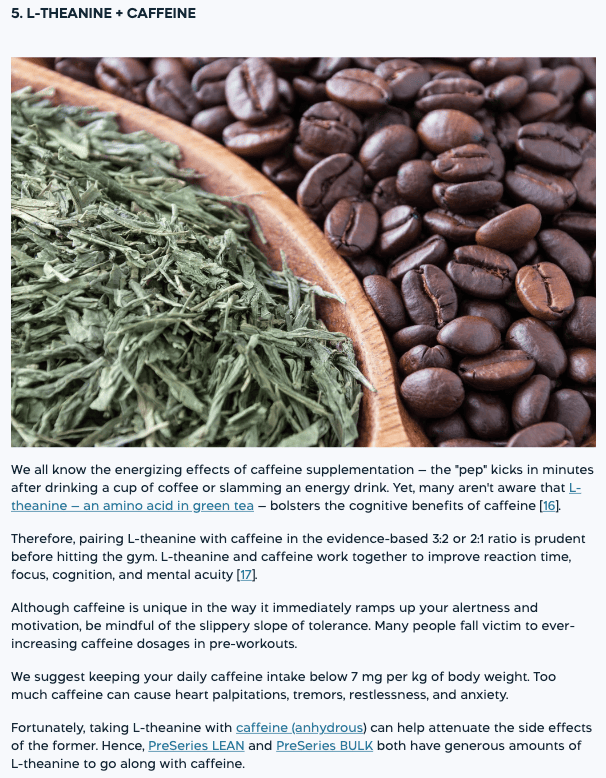
Source: transparentlabs.com
The second approach to catering for readers with a purchase intent is to give the post a very obvious product focus. Something like a deep-dive review on one specific product, a roundup of competing products, or perhaps a detailed comparison of two leading products.
Readers who have made a decision to purchase and are now just looking for the product that best suits their needs are often on the lookout for content like this. Take a look at Eachnight for an example. Their review on Mattresses Without Fiberglass gives readers an incredibly detailed look at the mattress brands that compete in this industry niche.

Source: Eachnight.com
Showcase Your Product at Its Best
Using visuals to inspire sales on your website shouldn’t only be reserved for your homepage and product pages. After all, imagery can have a profound conversion-boosting potential.
A scientific study from 2021 examined the connection between images and text in user-submitted reviews on ecommerce sites. The study discovered that product reviews that included visuals positively impacted consumers’ trust and purchase intention, especially for hedonic products.
So, if you’re interested in employing science-backed ways to drive growth through your blog, you should seek opportunities to populate your blog with attractive, purchase-inspiring photos.
Of course, this doesn’t mean you should substitute your written blog content with out-of-context product galleries. Instead, it means that you should still publish valuable information but use images (especially if you’re a lifestyle brand) to plant a seed of emotional investment in your products.
For example, if you check out the Gili Sports blog, you’ll see how effectively the brand employs this tactic. In their How to Paddle Board for Beginners post, the brand gives readers an in-depth overview of everything they need to know about the sport. Plus, it uses beautiful imagery to supplement the text.
What stands out in this particular example is that GILI is a lifestyle brand — it’s not just selling a product but an idea of a carefree, active, outdoorsy lifestyle. By employing images that show people doing these things, being happy, and being surrounded by breathtaking nature, GILI is letting its readers know that they, too, could be as content as the people in the photos.
The only condition? That they invest in one of the brand’s inflatable SUPs.

Source: gilisports.com
Create Exceptional Authority for Your Brand
One of the main challenges businesses must overcome in 2023 is the declining consumer trust in business.
A recent report from PWC discovered that while 87% of business leaders think their customers trust their brands, only 30% of consumers feel they can rely on brands to put their needs first. And knowing that trust equals conversions (and, therefore, growth), businesses need to look for new and effective strategies to build credibility.
The great thing about content marketing is that it can be a powerful tool for achieving precisely this goal.
By producing and publishing content for readers in the evaluation stage of the sales funnel and focusing on building authority, businesses can effectively encourage readers to perceive them as industry experts, thus boosting the chances of those readers converting into customers.
For example, check out the content marketing strategy of a brand like OwlLabs. Even a superficial glance will demonstrate that this organization’s primary aim is to position itself as an authority on remote work.
In its State of Remote Work report, the brand covers a popular topic with immense attention to detail and points out that it collaborated with the “leading remote work consulting firm Global Workplace Analytics” and “surveyed over 2,300 full-time U.S. workers.”
Furthermore, the end of the blog post features informative sections about both brands, emphasizing that OwlLabs is a company revolutionizing the concept of collaboration and that it won TIME’s 100 Best Innovations award in 2020.
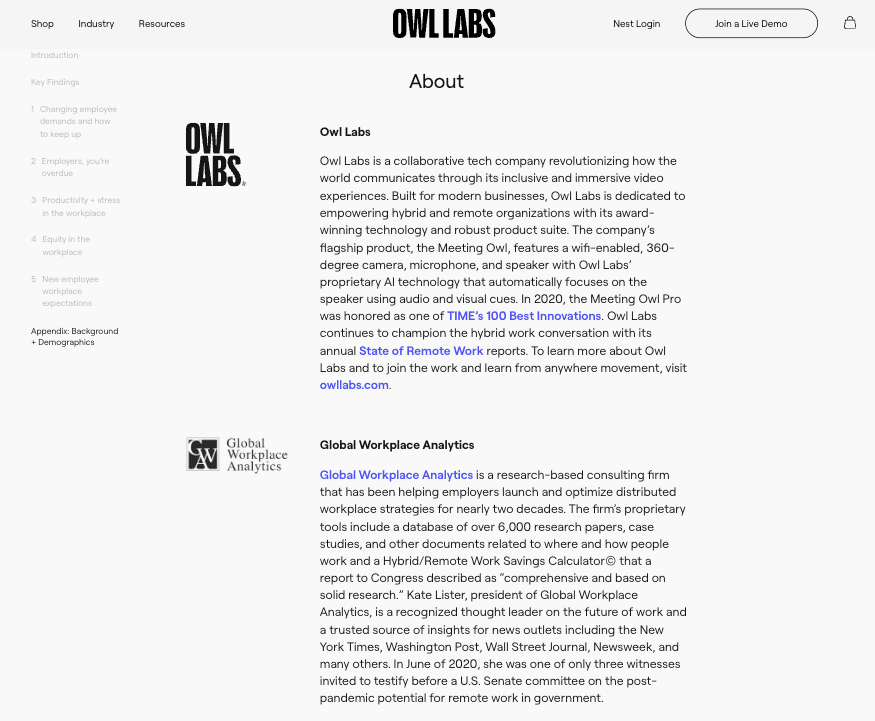
Source: owllabs.com
SaaS brands also do this marvelously. Particularly when aiming to convert professional users.
For instance, if you check out the Asana blog section, you’ll see that it’s filled with in-depth guides, customer stories, and case studies. They all have one thing in common: they highlight the brand’s authority.
For instance, in an article discussing organizational productivity, Asana invites a guest author, a professor of economics at Stanford University who happens to be “an Asana academic partner.”
Additionally, the resource consistently refers to data from the brand’s latest Anatomy of Work report, another excellent way to call readers’ attention to the fact that this is a reputable brand they can trust to solve their pain points.
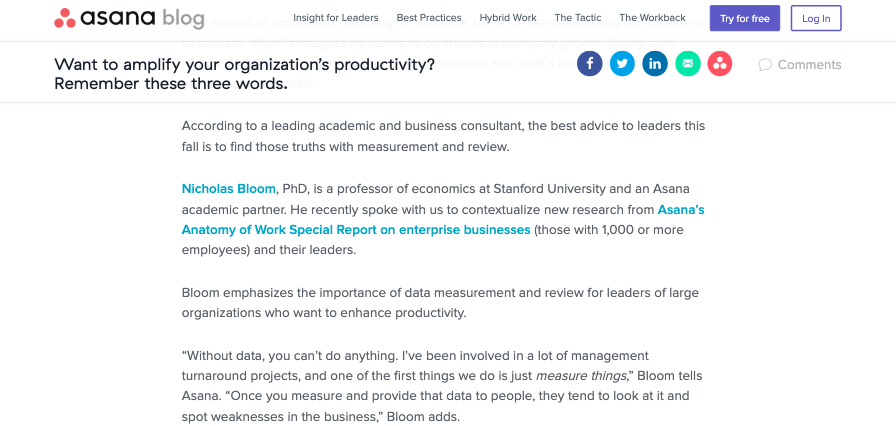
Source: asana.com
Understand How Content Can Support Your Sales Team
Another superb way to use content to boost sales is to employ it in a way that will support your sales team.
If you’re a B2B organization, you most likely have to push potential customers through a complex and time-consuming sales cycle. Considering that every buying decision your prospects make needs to be approved by six to ten decision-makers, your sales team has to answer a lot of questions and overcome specific conversion obstacles.
Now, if you understand what your sales team is doing (and the sort of interactions they’re having with potential buyers), you can make their job at least a bit easier by producing the right type of content.
By publishing articles that address your leads’ objections to conversion, you can create resources your sales team can send to potential buyers to help them make better purchasing decisions. Even more, you can use this content to entirely circumvent your potential customers having to ask your sales team for help, shortening their buyer’s journey and getting more of them to convert.
For instance, if you check out the About Mailchimp Pricing Plans from the email marketing automation platform, you’ll see that it’s precisely the type of article published to support the brand’s sales team.
The blog post provides handy definitions, explaining key concepts to first-time users. Furthermore, it gives overviews of the main features, benefits, (and limitations) of each plan. And it introduces alternative pricing strategies, such as the Pay As You Go and optional Add-ons.
The post is a genuinely helpful piece of content that explains everything a potential customer would want to learn about MailChimp’s pricing policies. And by tackling the subject so efficiently, the article doesn’t just encourage conversions. It also solidifies the organization’s reputation as a reliable SaaS business.
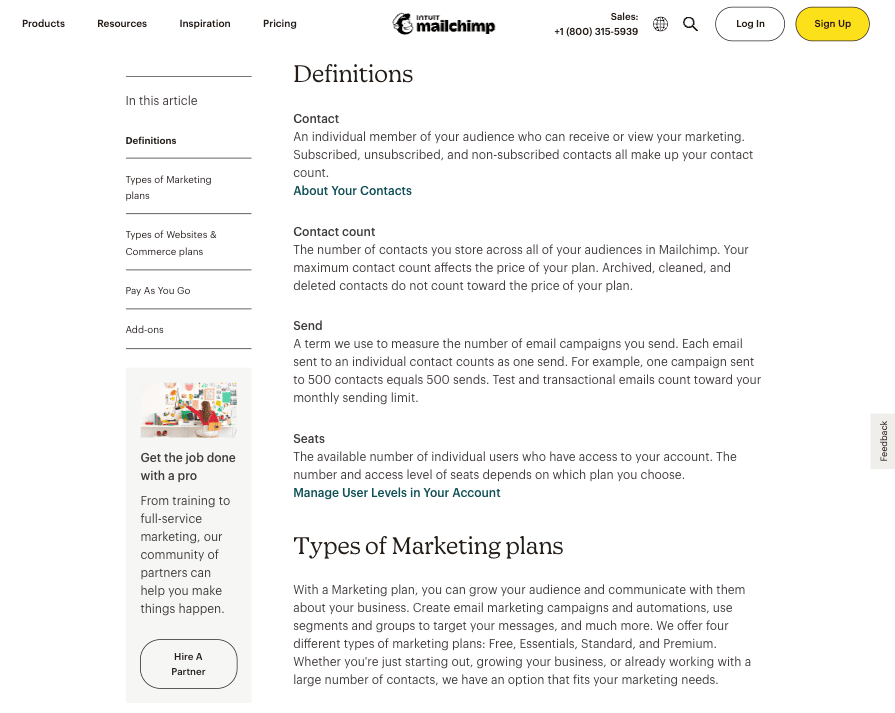
Source: mailchimp.com
Monetize Your Premium Content
Finally, as you explore ways to use your company blog to maximize your revenue, don’t forget that, in some cases, the solution to getting more out of your content marketing strategy is to monetize your premium content.
By putting original and unique content behind a paywall, like the Nielsen Norman Group did with its How People Read Online eye-tracking evidence report, you can turn your content strategy into a direct source of income. Adopting this approach can also help you highlight the value offered by your original research, making it much more valued by your target audience.
Of course, note that this particular brand still gives away some of its findings for free. This has allowed the organization to position itself as the ultimate authority on UX and website readability.
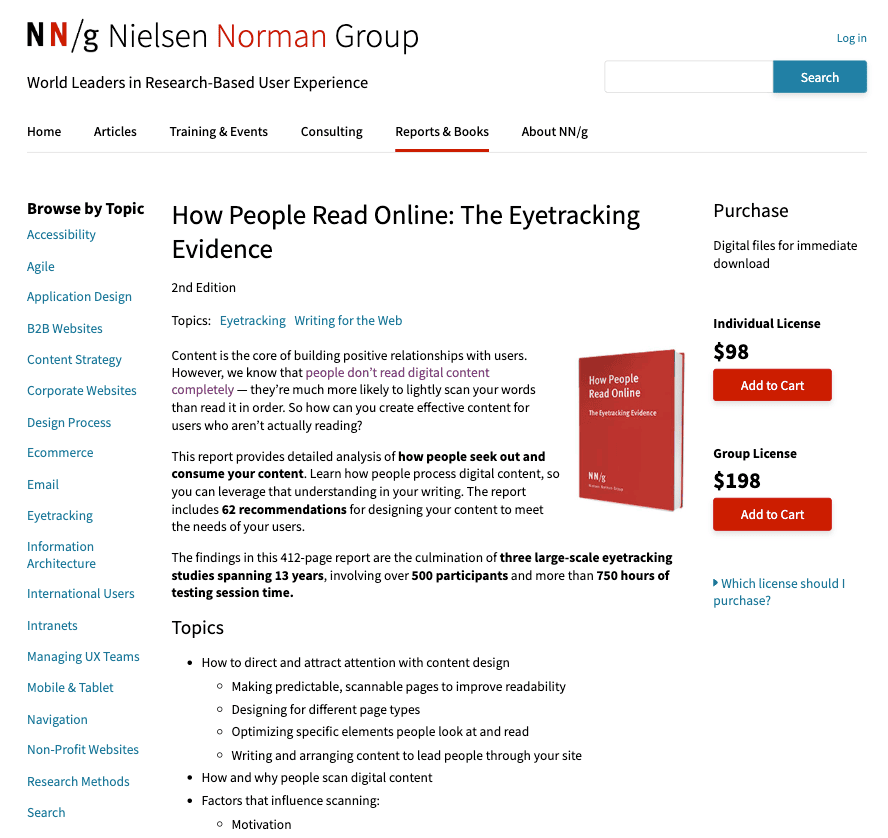
Source: nngroup.com
Or, in a similar fashion, you can make your evergreen content available to all web visitors but introduce advanced interactive elements that can be monetized.
This is what MarketBeat does in their Best Dividend Stocks analysis. The post is updated daily and allows users with an All Access Subscription to filter the highest-performing company stocks based on MarketRank, media sentiment, and (perhaps most importantly) analyst recommendation consensus.
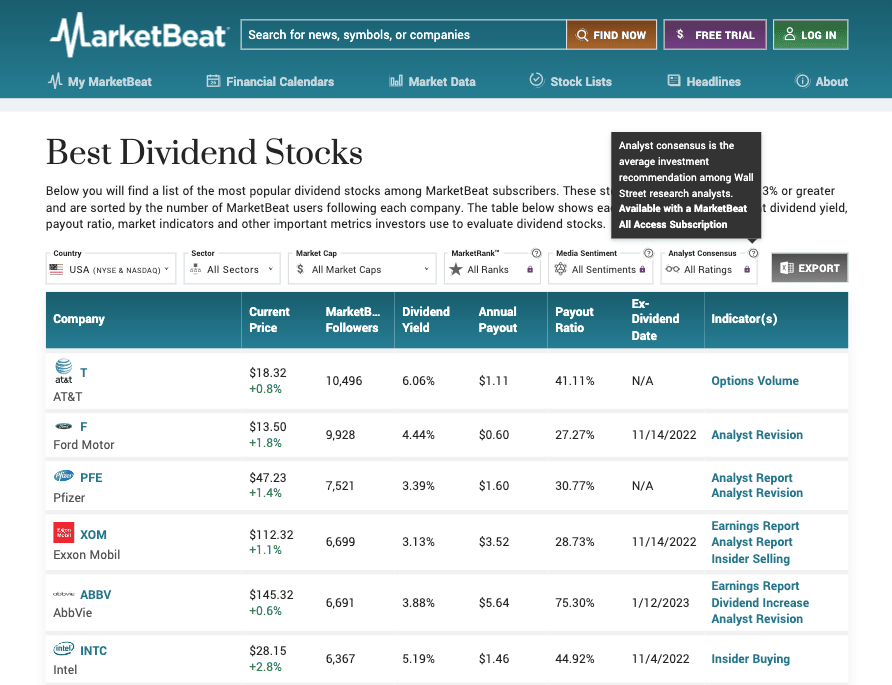
Source: marketbeat.com
In Closing
Investing in content marketing to boost organic traffic to your website is always a great idea. But considering the fact that content creation (at least when it’s done right) necessitates a substantial amount of resources, you’ll want to get the biggest bang for your buck from every single post you publish.
By employing the strategies above, you can create a direct link between content and conversion and use your company blog to improve sales figures.
Of course, which of the tactics you decide to implement will depend on your brand, product, and target audience’s sensibilities. But you can rest assured that, using even just one of the six methods described in this article, you’ll achieve impressive results.
FAQ
What is the relationship between content and conversion in digital marketing?
Content plays a crucial role in conversion by providing valuable information and persuading visitors to take desired actions, such as making a purchase or filling out a form.
How can high-quality content improve conversion rates on a website?
High-quality content can build trust with visitors, address their pain points, and provide solutions, which can lead to increased conversion rates.
What types of content are effective for conversion optimization?
Content formats like persuasive landing pages, informative blog posts, engaging videos, and compelling product descriptions are effective for conversion optimization.
Why is it important to align content with the buyer’s journey for better conversion results?
Aligning content with the buyer’s journey ensures that visitors receive relevant information at each stage, increasing the likelihood of conversion.
How can A/B testing of content elements impact conversion rates?
A/B testing allows marketers to identify which content elements, such as headlines, calls to action, or visuals, are most effective in improving conversion rates.
What role does storytelling play in content-driven conversions?
Storytelling can create an emotional connection with the audience, making content more relatable and persuasive, ultimately leading to higher conversions.
How can content personalization contribute to higher conversion rates?
Personalized content tailors messaging to individual preferences, increasing the relevance of content and improving the chances of conversion.
What is the importance of clear and concise content in conversion optimization?
Clear and concise content eliminates confusion and allows visitors to quickly understand the value proposition, which can lead to faster conversions.
How does content distribution impact conversion opportunities?
Effective content distribution through channels like email marketing, social media, and SEO can increase visibility, driving more potential conversions.
What role does trust-building content play in conversion strategies?
Trust-building content, such as customer reviews, testimonials, and trust badges, can reassure visitors and remove barriers to conversion.
How can content optimization for SEO impact conversion rates?
Content optimized for search engines can attract more organic traffic, increasing the chances of conversion through improved visibility.
What are some effective content marketing strategies to boost conversion rates in e-commerce?
Strategies like product reviews, user-generated content, and interactive product demonstrations can enhance conversion rates for e-commerce websites.
How can content upgrades and lead magnets be used to improve lead generation and conversions?
Offering valuable content upgrades and lead magnets in exchange for contact information can boost lead generation and conversion rates.
What are some best practices for creating persuasive call-to-action (CTA) buttons in content?
Creating attention-grabbing CTA buttons with clear language and contrasting colors can encourage users to take action and improve conversions.
How does the use of social proof in content influence conversion decisions?
Social proof, such as user testimonials and case studies, can build credibility and trust, positively impacting conversion decisions.
What role does content relevancy play in reducing bounce rates and increasing conversions?
Relevant content keeps visitors engaged and decreases bounce rates, improving the likelihood of conversion.
How can video content be optimized for better conversion rates on landing pages?
Optimizing video length, adding captions, and including compelling CTAs in videos can enhance conversion rates on landing pages.
What impact can content localization have on global conversion strategies?
Localizing content for different regions and languages can make it more culturally relevant, leading to improved conversion rates in global markets.
How do content audits help identify opportunities for conversion rate optimization?
Content audits identify underperforming content and areas for improvement, contributing to better conversion rate optimization strategies.
What are the benefits of using storytelling in email marketing for higher conversion rates?
Incorporating storytelling into email marketing can engage recipients emotionally and drive them to take desired actions, resulting in increased conversions.
Create more and better content
Check out the following resources and Grow!